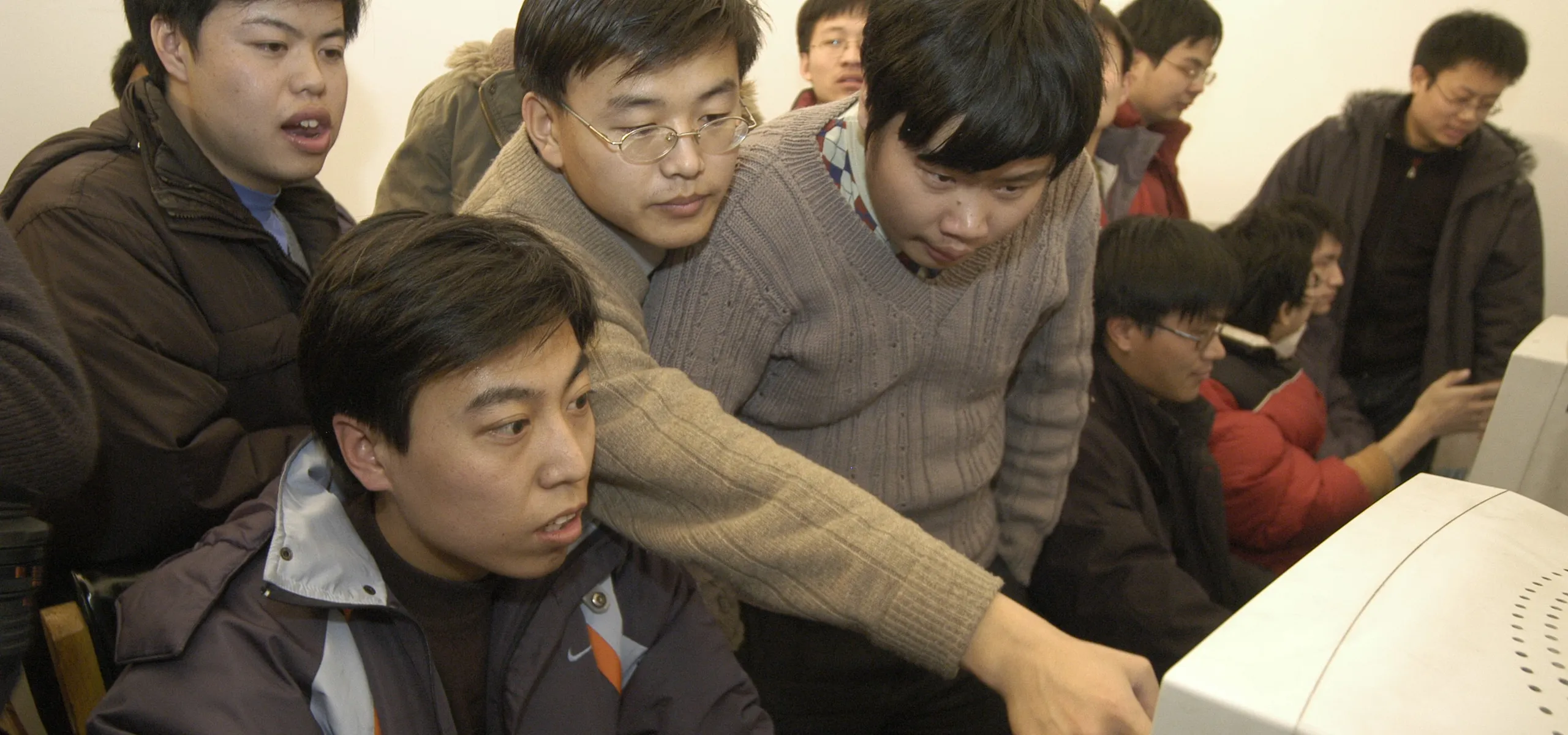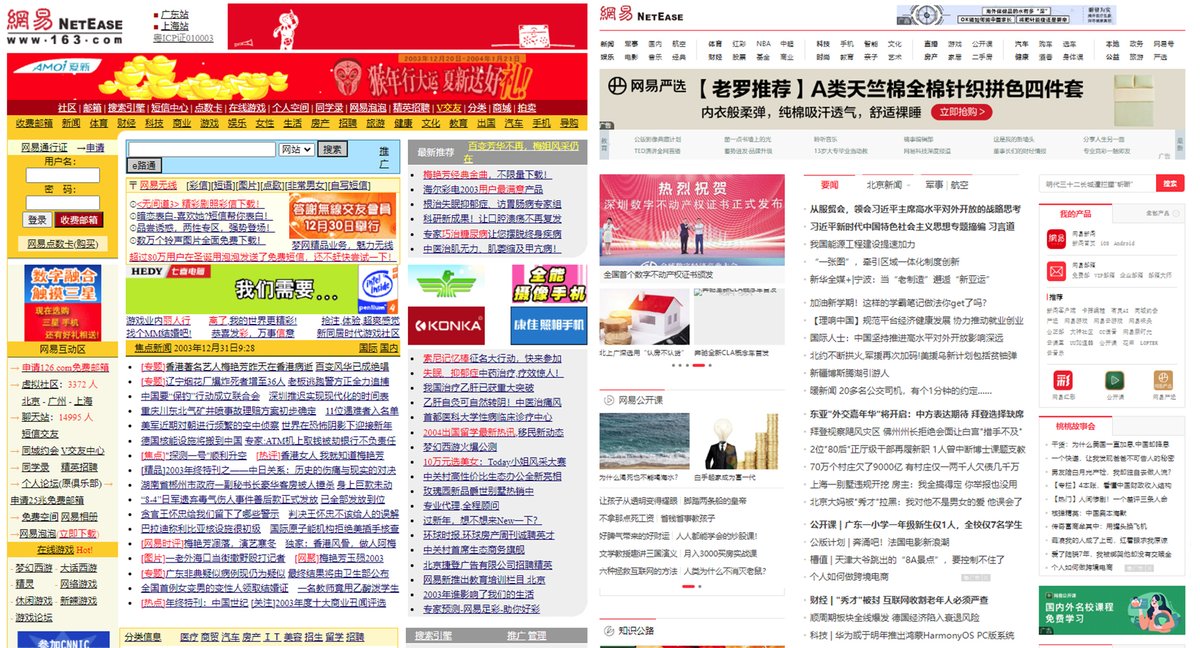And do people even care about websites in China’s mobile-centric society?
Navigating a Chinese website like the NetEase news and entertainment portal 163.com can feel like a digital archaeological dig, excavating the internet designs of yesteryears. Flashing banners, bright colors, and a chaotic collage of links can evoke a sensation of time travel.
In a country at the vanguard of digital innovations, where applications like the ubiquitous WeChat have revolutionized the concept of what an app can do, the stark contrast between modern mobile apps and seemingly outdated websites raises an intriguing question: Is the design harking back to the early days of the internet a mere aesthetic divergence or is there more to it?
Difficulties in design
Designing websites in the Chinese context has its unique challenges. Unlike Latin alphabets, character-based languages like Chinese have a limited selection of web fonts, which makes it challenging for designers to emphasize text, directly impacting users’ readability, as David Gilbert explains in a widely-shared 2013 analysis of Asian web design. The US-based user interface and experience consulting firm Nielsen Norman Group further notes that readability is not merely a matter of aesthetics but a fundamental factor influencing user experience.
However, this lack of textual emphasis and increased logographic “clutter” on websites may not necessarily have a negative impact on Chinese users’ specific experience. Tech content creator Cynthia Zhou in her analysis of Asian web design argues that the design of these sites may be intentionally “cluttered” because Chinese can be considered “holistic thinkers” who are able to process dense information faster as suggested by research in psychology. Further research in psycholinguistics shows that Chinese readers tend to move their eyes asymmetrically, akin to “scanning” a page with less focus on individual elements, and may therefore be able to process a “cluttered” page faster.
Still, Cheng Yunnuo and Jakob Nielsen from the Nielsen Norman Group find in their website usability study using empirical testing that while Chinese users may be used to “cluttered” sites visually and find them to be normal-looking, they still experience significant usability issues like difficulty in finding essential information or functions across a range of websites from news portals like 163.com to banking and shopping sites.
The one app to connect them all
Given the outdated design, it’s not surprising that websites seem to have little significance in the everyday lives of Chinese people. Take e-commerce as an example: In Yiwu, China’s largest market for small commodity goods, one can hardly find any URLs on most business cards, not even Yiwu’s official e-commerce portal where businesses have their online stores—because the website sales are negligible. “I rarely sell things on there,” one LED candle seller tells TWOC.
Instead, most business cards prominently feature a QR code that takes customers directly to the business’s WeChat account, providing access to their WeChat Moments feed where goods are regularly showcased, sometimes with pricing and other relevant information.
The same seems to ring true in the field of education. “It’s ugly,” one graduate from the Yiwu Industrial and Commercial College tells TWOC about the institution’s official website. “I’ve been on there before, but it’s not easy to use.” The mostly static site, harking back to the early days of the internet, mainly consists of columns of links. Interestingly, some of these links redirect visitors to WeChat again where new students can go through the enrollment process, and get access to relevant updates and information—not just through the regular content updates on the institution’s official WeChat account (comparable to a Facebook page), but also through private student groups where important information is constantly shared.
The sleek app is user-friendly and strikingly similar to Western apps in terms of layout, color scheme, and overall user experience, proving that a platform can be well-designed even with challenges presented by Chinese characters. “Good design is good design,” as Cheng and Nielsen assert, pointing out that there are universally shared patterns of perception designers know to leverage. Whether in Beijing or Boston, designers could employ principles that are not culturally or linguistically determined but rather a facet of shared human cognitive patterns.
Technological leapfrogging
China’s early internet culture was a dynamic, burgeoning ecosystem brimming with online forums and fan communities. But despite this rich digital landscape, China’s general population had relatively limited access to PCs and most people could only go online in internet cafes, or wangba. According to Pew Research, PC usage in China stood at 35 percent of the total population in 2002 and had modestly grown to 40 percent by 2007—with PC ownership much lower than that. These figures are markedly lower than those in the United States, where PC usage was more than double that. In 2007, when the launch of the iPhone had already set off a wave of simplified, mobile-friendly user interface design in the West, only about 210 million people, or roughly 16 percent of China’s total population, had access to the internet.
The limited popularity of PCs and the internet in China during the early 2000s stands in stark contrast to the country’s rapid adoption of smartphones in the late ’00s. In 2009, China launched its 3G networks, and within three years, it had already surpassed other countries and regions to become the world’s largest smartphone market by volume. This leapfrogging may also explain why China has become so advanced in the realms of smartphone design, app design, and in-app ecosystems. While Western countries were gradually shifting from PCs to mobile, China made that shift rather abruptly, bypassing several transitional phases that would have otherwise reoriented its web design approaches. A similar technological “leapfrog” happened in many African countries, where landlines were skipped and large parts of the population went straight to cell phones during the ’00s.
In essence, China went straight from an era of internet cafes and the early web to a mobile-centric paradigm. This rapid transition to a smartphone-centric digital environment becomes even more apparent when one considers smartphone penetration rate. According to Google’s Our Mobile Planet study from 2013, China had already achieved a 47 percent smartphone penetration rate, not far behind the US at 56 percent. Fast forward ten years, China now has the most smartphone owners globally, with a penetration rate of a staggering 70 percent, only about 10 percent behind the US according to the market research firm Newzoo.
This incredible pace of adoption can be attributed to a multitude of factors that made the mobile internet more accessible and appealing to the Chinese population. Engineer John Kou in his interview with the South China Morning Post credits the ”Cun Cun Tong” program, a central government initiative that directed state-owned telecom operators to build network base stations in rural areas, for the country’s rapid transition to mobile phones and mobile internet. For about 15 years, from 2000 onward, China expanded both fixed and mobile networks to remote towns and villages, effectively narrowing the country’s urban-rural digital divide and paving the way for the widespread adoption of mobile technology. Economist Winston Wenyan Ma also notes that for many people in China, particularly in rural areas, their first interaction with the internet is mobile-based. “In other words, the Chinese population has transitioned directly to a mobile-first, mobile-only era,” writes Ma in LSE Business Review.
Anson Zong-Liscum, a Yunnan-based business owner, experienced first-hand how businesses have to adapt to the mobile-centric society. “Everything is mobile here. Either you develop your WeChat official account, or Xiaohongshu (a Chinese Instagram-like app), or Douyin (China’s TikTok). These are the only ways people will come across you,” says Zong-Liscum.
He registered his company on two popular mobile apps in China—Baidu Maps and Gaode Maps—so locals can find his store more easily. ”They’ll look you up usually through these routes compared to a website…Everything is so phone-focused,” Zong-Liscum explains.
The paradox of China’s digital landscape isn’t just a peculiar cultural phenomenon but a reflection of the rapid, nonlinear path China took in its digital evolution. The labyrinthine layers of a Chinese website are a unique intersection of history, culture, and technological leapfrogging—an intricate mosaic of a digital realm, where 163.com coexists with TikTok, as multifaceted and paradoxical as the nation that hosts it.
Disclosure: Anson Zong-Liscum is TWOC’s digital content manager.















